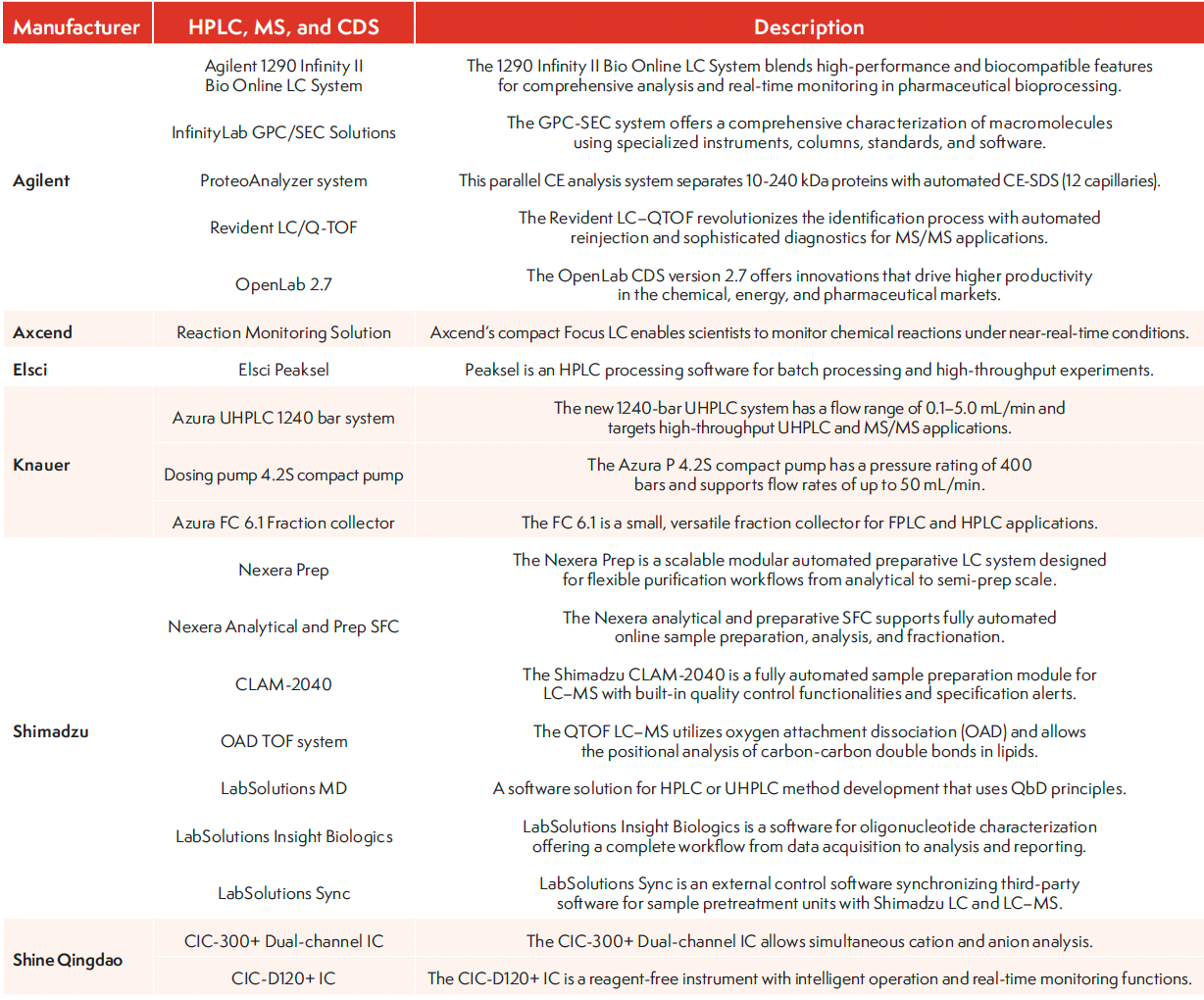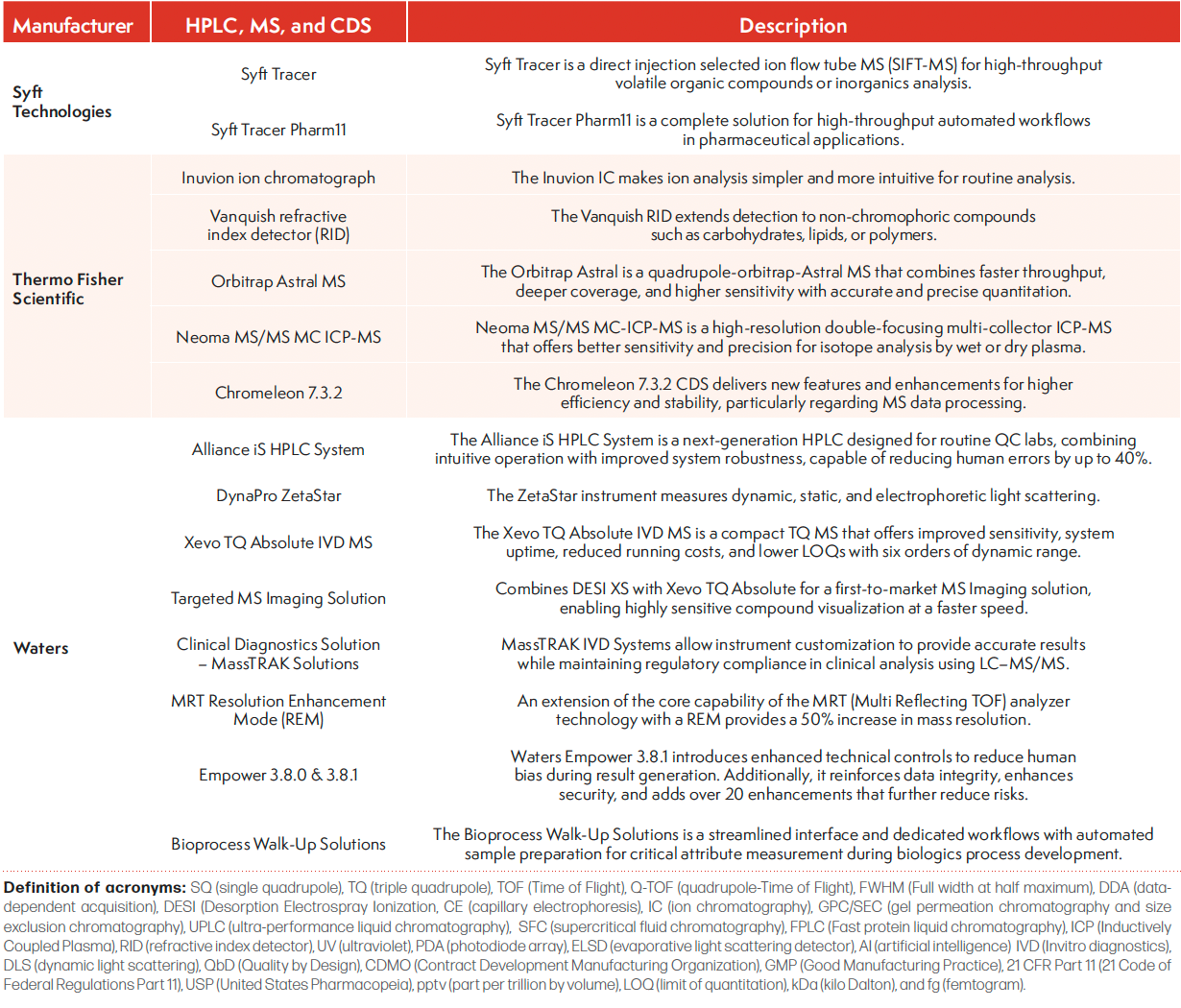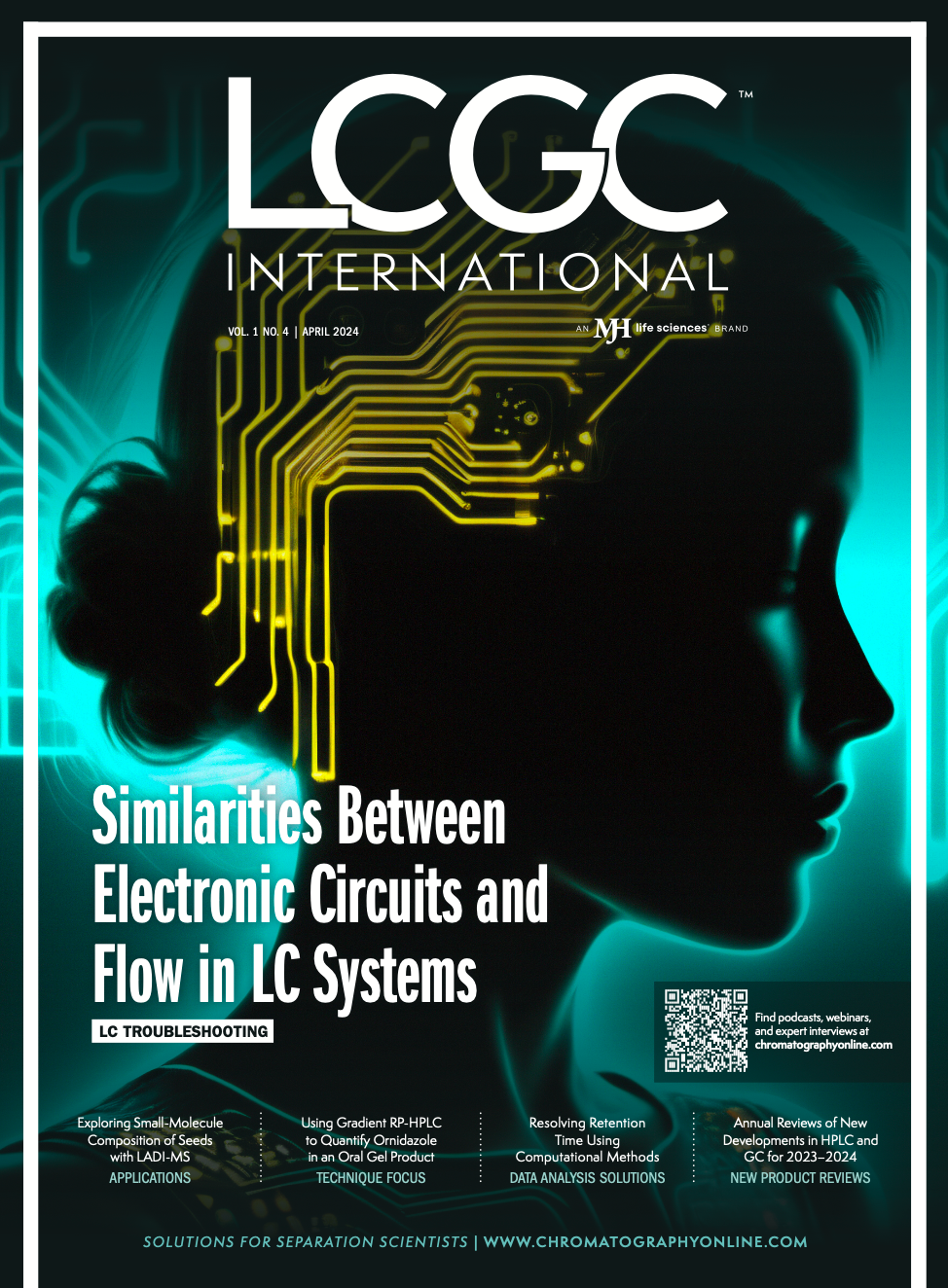New HPLC, MS, and CDS Products Introduced in 2023–2024: A Brief Review
The 75th Pittcon was held at the San Diego Convention Center, California, on February 24–28, 2024, for the first time on the West Coast. San Diego, a city of 1.3 million, is renowned for its moderate year-round temperatures and outstanding tourist attractions (including Gaslamp Quarter, Balboa Park, the San Diego Zoo, Sea World, La Jolla, Coronado, and Legoland), and academic and industry centers (UC San Diego, Scripps Institute, Salk Institute, Qualcomm, and Illumina). Its proximity to Los Angeles and the availability of many moderately priced hotels make it an ideal conference venue. The Pittcon organizer recently changed the meeting locations from a four-city rotation of Philadelphia, Chicago, Atlanta, and New Orleans to a new city list of San Diego, Boston, and San Antonio. We hope exhibitors and attendees will embrace these exciting locations.
HPLC and MS New Product Introduction 2023–2024
Table I lists new product introductions ordered alphabetically by the vendor’s name, categorized as high-performance liquid chromatography (HPLC) systems, modules, mass spectrometry (MS), chromatography data systems (CDS), and other software. Each product’s innovative features and benefits are briefly described, including a summary of pertinent specifications. The footnotes of Table I contain the definitions of common acronyms used in the table and text.
Table I: Summary of new HPLC, MS, and CDS products in 2023-2024

Table I (Continued): Summary of new HPLC, MS, and CDS products in 2023–2024.

HPLC and UHPLC Systems (Including IC, CE, and Preparative LC)
This section describes new HPLC, ultrahigh-pressure liquid chromatography (UHPLC), ion chromatography (IC), capillary electrophoresis (CE), and supercritical fluid chromatography (SFC) systems and their salient features, benefits, and technical specifications.
Agilent
1290 Infinity II Bio Online LC System
The 1290 Infinity II Bio Online LC System blends high-performance and biocompatible features for comprehensive analysis and real-time monitoring in pharmaceutical bioprocessing. It offers advanced control over process analytical technology (PAT) needs. The system facilitates precise biomolecule separations and analyses alongside real-time process monitoring, optimizing processes quickly to save time and resources. Agilent’s online monitoring software allows remote monitoring and control of chromatography systems, providing alerts and data analysis with minimal effort.
InfinityLab GPC/SEC Solutions
The GPC/SEC system offers a comprehensive characterization of macromolecules using specialized instruments, columns, standards, and software, including advanced multidetectors such as multi-angle light scattering, micro-refractive index detection, and improved GPC software (WinGPC) on the OpenLab CDS. The system can handle high-temperature GPC (up to 220 oC).
ProteoAnalyzer System
This parallel CE analysis system separates 10–240 kDa proteins with automated CE-SDS (12 capillaries). A streamlined workflow labels proteins with fluorescent tags detected with a charged-coupled device (CCD) camera for quantitation. It provides an all-in-one analysis with powerful software (ProSize data analysis).
Axcend
Reaction Monitoring Solution
Axcend’s compact Focus LC for process analytical technology (PAT) can be placed adjacent to a reaction vessel, enabling scientists to monitor chemical reactions under near-real-time conditions. The miniaturized LC is compatible with the Agilent OpenLab Chemstation edition and the DataApex Clarity CDS.
Knauer
Azura UHPLC 1240 Bar System
The new 1240-bar UHPLC system has a flow range of 0.1–5.0 mL/min and targets high-throughput UHPLC and MS/MS applications.
Shine Qingdao Shenghan Chromatograph Technology
CIC-300+ Dual-channel IC
The CIC-300+ Dual-channel IC allows simultaneous cation and anion analysis. It has a built-in eluent generator, vacuum degassing, consumables monitoring, and real-time monitoring functions with auto-ranging conductivity detection.
CIC-D120+ IC
The CIC-D120+ IC is a reagent-free instrument with intelligent operation and real-time monitoring functions, including leak detection, automated startup and shutdown, and auto-ranging conductivity detection.
Shimadzu
Nexera Prep
The Nexera Prep is a scalable modular automated preparative LC system designed for flexible purification workflows from the analytical to the semi-prep scale (1 mg to 2 g, with flow rates from 0.1 to 150 mL/min). The system is equipped with multiple detector options.
Nexera Analytical and Prep SFC
The Nexera analytical and preparative SFC and supercritical fluid extraction system supports fully automated online sample preparation, analysis, and fractionation for high recovery preparative purification.
Thermo Scientific
Inuvion Ion Chromatograph
The new Thermo Scientific Dionex Inuvion IC makes ion analysis simpler and intuitive for routine analysis with an intelligent design, automated startup and shutdown routines, built-in diagnostics, and reagent-free operations. It is a compact IC on a flexible and upgradable platform.
Waters
Alliance iS HPLC System
The Alliance iS HPLC System (intuitive simplicity) is a next-generation HPLC system with a quaternary pump and a UV absorbance detector that reduces common laboratory errors, operator training requirements, and method transfer time. The Alliance iS HPLC System improves pharmaceutical quality control laboratories’ productivity and data quality through its intelligent design, intuitive touchscreen operation, built-in error-reducing features, and intelligent method translation apps. The system was introduced in March 2023. Updated specifications include a gradient delay volume <1000 mL, a flow range of 0.001 to 10 mL/min, maximum pressure of 10,000 psi, a pH range 1 to 13, a flow accuracy of ±1%, compositional accuracy of ±0.5%, an injection precision of <1.0% to <0.25% depending on injection volumes using flow-through needle design, and sample carryover of ≤0.002%.
HPLC Module (Including Sample Preparation Module)
Knauer
Dosing Pump 4.2S Compact Pump
The Azura P 4.2S compact pump is the successor to the P 2.1 and P 4.1 pump family. The pressure rating is 400 bars and supports flow rates up to 50 mL/min.
Azura
FC 6.1 Fraction Collector
The FC 6.1 is a small, versatile fraction collector for fast protein liquid chromatography (FPLC) and HPLC applications. It can be used for flow rates from 0.1 to 250 mL/min and offers space for a main rack and a small side rack. The main rack can hold 3 x 96 well plates, 165 x 1.5/2 mL tubes, 99 x 15 mL tubes, or 30 x 50 mL tubes. The side rack offers space for 3 x 250 mL bottles.
Shimadzu
CLAM-2040
The Shimadzu CLAM-2040 is a fully automated sample preparation module for LC–MS with built-in quality control functionalities and specification alerts. The 2040 module automatically performs all processes necessary for analyzing biological samples, including sample and reagent pipetting, mixing, heating, vacuum filtration, and transferring the extracted sample to the LC–MS system autosampler. It can prepare up to three samples simultaneously and deliver a result every 2.6 min under optimized conditions.
Thermo Scientific
Vanquish Refractive Index Detector
The Vanquish refractive index detector (RID) extends detection to non-chromophoric compounds such as carbohydrates, lipids, or polymers. The new detector saves bench space and offers leak detection and safe handling.
Waters
DynaPro ZetaStar
The ZetaStar DLS (dynamic light scattering) instrument measures dynamic, static, and electrophoretic light scattering. It provides data on size and size distribution, zeta potentials (charge), particle concentrations, turbidity, and stability indicators of nanoparticles and biological drug products. It can be paired with the ARC HPLC autosampler to support the expanding needs of biopharma formulation and development laboratories. The ZetaStar instrument helps scientists in gene therapy, vaccines, mRNA, and protein analysis in developing more stable formulations.
Mass Spectrometers (MS)
Agilent
Revident LC/Q-TOF
The Revident LC/Q-TOF revolutionizes the identification process with smart automated reinjection and sophisticated diagnostics for MS/MS applications with multiple workflow capabilities, combining excellent isotope fidelity, mass accuracy, and dynamic range. The three common workflows include Intelligent Reflex, targeted MS/MS for suspect confirmation, and iterative MS/MS.
Shimadzu
OAD TOF System
The quadrupole time-of-flight (Q-TOF) LC–MS utilizes oxygen attachment dissociation (OAD). This proprietary Shimadzu fragmentation technology allows the positional analysis of carbon–carbon double bonds in lipids and other organic compounds. Collision-induced dissociation (CID) is also possible with this system, and users can seamlessly switch between OAD and CID for analysis.
Syft Technologies
Syft Tracer
Syft Tracer is the next generation of real-time, direct injection selected ion flow tube MS (SIFT-MS) optimized for high-throughput volatile organic compounds or inorganics analysis. The system uses microwave discharge for ion generation and MS/MS detection and quantitation. The mass range is 10–400 amu, with low sensitivity.
Syft Tracer Pharm11
Syft Tracer Pharm11 is a complete solution for high-throughput, 21 CFR Part 11 compliant, automated workflows in pharmaceutical contract development and manufacturing organization (CDMO) applications. Critical quality tests for drug impurities like nitrosamines, ethylene oxide, residual solvents, formaldehyde, and others can be performed in real time. The system can perform headspace extraction, dissolution in aqueous solvents, or non-polar alternatives, and direct sampling from powder or solid headspace.
Thermo Scientific
Orbitrap Astral MS
The Thermo Scientific Orbitrap Astral is a quadrupole-orbitrap-Astral MS that combines faster throughput, deeper coverage (for proteomics sequencing), and higher sensitivity while delivering accurate and precise quantitation. It has a mass range of 40–6000 m/z (or up to 8000 with the biopharma option), a dynamic range of >5000 in a single microscan, a mass resolution of 480,000 (fwhm) in the Orbitrap analyzer, and 80,000 in the Astral analyzer, an MS/MS mass accuracy of <3 ppm in the Orbitrap analyzer and a <5 ppm in the Astral analyzer, a scan rate of 200 Hz in the Astral analyzer, and single-ion sensitivity of 50 fg of reserpine with the Astral analyzer.
Neoma MS/MS MC ICP-MS
Neoma MS/MS MC-ICP-MS is a high-resolution double-focusing multi-collector ICP-MS that filters out the noise for better sensitivity and precision for isotope analysis by wet or dry plasma.
Waters
Xevo TQ Absolute IVD MS
The Xevo TQ Absolute IVD MS is a compact triple quadrupole (TQ)-MS that offers improved sensitivity, system uptime, reduced running costs, and lower limits of quantitation (LOQs) with six orders of dynamic range.
Targeted MS Imaging Solution with DESI XS and Xevo TQ Absolute
The DESI XS MSI is typically applied for mapping small molecules directly from tissue sections and, combined with TOF-MS, is ideally suited for untargeted discovery analysis. On the other hand, TQ-MS systems are renowned for their sensitivity, speed, and quantitative robustness for targeted applications using multiple reaction monitoring (MRM) modes of acquisition, and they are widely adopted for drug quantitation. Combining the two technologies, a remarkable and unique technique emerges to perform sensitive, fast, and quantitative MSI directly on the surface.
Clinical Diagnostics Solution–MassTRAK Solutions
MassTRAK IVD systems allow instrument customization to provide accurate results while maintaining regulatory compliance in clinical analysis using LC–MS/MS with an I-Class Acquity UPLC coupled to Xevo and TQ-S micro or TQ Absolute IVD systems. They support columns, reagents, sample handling, automation, and informatics solutions.
MRT Resolution Enhancement Mode (REM)
Recent updates for the Select Series MRT were introduced to improve specificity and utility for UPLC–MS/MS metabolomics, drug discovery applications, and mass spectrometry imaging experiments. The MRT System now offers a new resolution enhancement mode (REM) that provides 50% higher resolution, making it capable of 300,000 fwhm resolution and a 3X faster scan rate, while maintaining its parts-per-billion (ppb) mass accuracy.
Chromatography Data System (CDS) and Other Software
Agilent
OpenLab 2.7
The latest release of OpenLab CDS version 2.7 offers innovations that drive productivity to a higher level in the chemical, energy, and pharmaceutical markets, including calibration curve improvements, integration optimizer enhancements, centralized unattended printing, and cloud-based help and learning.
Elsci
Peaksel
Peaksel is an HPLC processing software for high-throughput experiments. It has a browser-based interface to facilitate collaboration and data sharing with Spotfire-like visualizations to eliminate the need for Microsoft Excel. It has templates to promote standardization, an application programmatic interface to enable automation, and batch-processing capabilities for high-throughput workflows.
Shimadzu
LabSolutions MD
LabSolutions MD is a software solution for HPLC or UHPLC method development using analytical quality by design (AQbD) principles. It improves the efficiency of analytical method development by screening for optimum parameters, such as columns and mobile phases, using design of experiments (DoE). An AI-driven automated gradient optimization function also tests and predicts the best gradients to achieve the user’s set parameters, such as resolution and tailing factor. LabSolutions MD works with LC, SFC, and most detectors, including UV, photodiode array (PDA), evaporative light scattering detector (ELSD), and single quadrupole MS (SQMS).
LabSolutions Insight Biologics
LabSolutions Insight Biologics is a software for oligonucleotide characterization offering a complete workflow from data acquisition to analysis and reporting. For use with the Q-TOF LCMS-9030/9050, it enables confirmation of products and identification of unknowns. It uses data dependent acquisition (DDA)-MS/MS to provide base-by-base sequence information, site-specific modifications, and sequence mapping in nucleic acid pharmaceuticals.
LabSolutions Sync
LabSolutions Sync is an external control software that synchronizes third-party software for sample pretreatment units (robotics or centrifuge) with a Shimadzu LC and LC–MS.
Thermo Scientific
Chromoleon 7.3.2
The Chromeleon 7.3.2 CDS delivers new features and enhancements for higher efficiency and stability, particularly regarding MS data processing. It guides operators with a customizable user interface and reporting engine and streamlines the handling of custom variables. It simplifies the support of good manufacturing practices (GMP) guidelines to ensure data integrity and traceability.
Waters
Empower 3.8.0
The new features of Waters Empower 3.8.0 include views of audit trails and user types, calculations based on USP <621> and EP 11, assignable privileges, Empower method validation signature/workflow optimization, intensity label levels for the spectrum index plot and the mass analysis plot, and Alliance iS HPLC system functionality suite with eConnect column technology.
Empower 3.8.1
Waters Empower 3.8.1 includes a suite of enhancements that highlight compliance, data quality, and security. The new features include technical controls for data processing, minimizing human bias during result generation. Audit trail entries have been fine-tuned to ensure data integrity by locking channels manually versus with a signature.
Bioprocess Walk-Up Solutions
The Bioprocess Walk-Up Solutions is a streamlined interface for dedicated workflows with automated sample preparation and LC–MS analytics. The interface allows a combination of the Andrew+ Pipetting Robot and the BioAccord LC–MS System to provide rapid sample processing from bioreactor systems for high-quality results with minimal user interaction.
Summary and Commentaries
This installment provides an overview of new separation science products introduced in 2023–2024. It summarizes innovative features, key benefits, and pertinent specifications of these new HPLC, MS, CDS, and other software products.
I have attended Pittcons for four decades, and Pittcon 2024 remained a rewarding and inspiring experience. Unfortunately, the number of exhibitors was significantly reduced post-pandemic, and several major manufacturers (Agilent, Thermo Fisher Scientific, Sciex, and Waters) were absent from the exhibition hall this year. I want to appeal to all instrument manufacturers to reconsider returning to the most prominent American laboratory conference to benefit laboratory scientists and consumers seeking to purchase new equipment, software, and consumables. I hope the Pittcon organizing committee will continue to deliver a conference of increasing relevance to the analytical science community and instrument manufacturers. I fervently hope to see more manufacturers at the exhibition halls of Pittcon 2025 in the city of Boston, the new pharmaceutical hub in America.
Acknowledgments
The author thanks the marketing staff of all manufacturers who provided timely responses to the LCGC questionnaires. A special thanks to my reviewers for providing timely technical and editorial inputs to this article: Alice Krumenaker of Hovione, Mengling Wong and Bifan Chen of Genentech, Alec Valenta of Thermo Fisher Scientific, Janice Foley of Waters, He Meng of Sanofi, Leon Doneski of Arcutis Biotherapeutics, Giorgia Greco of KNAUER, Emanuela Gionfriddo of U. Buffalo, and Stanislav Bashkyrtsev of Elsci. Their input is invaluable for the accuracy and clarity of this article.
About the Column Editor
Michael W. Dong is a principal of MWD Consulting, which provides training and consulting services in HPLC and UHPLC, method improvement, pharmaceutical analysis, and drug quality. He was formerly a Senior Scientist at Genentech, a Research Fellow at Purdue Pharma, and a Senior Staff Scientist at Applied Biosystems/PerkinElmer. He holds a PhD in Analytical Chemistry from City University of New York. He has more than 130 publications and a bestselling book in chromatography. He is an editorial advisory board member of LCGC North America and the Chinese American Chromatography Association. Direct correspondence to: LCGCedit@mmhgroup.com.


New Method Explored for the Detection of CECs in Crops Irrigated with Contaminated Water
April 30th 2025This new study presents a validated QuEChERS–LC-MS/MS method for detecting eight persistent, mobile, and toxic substances in escarole, tomatoes, and tomato leaves irrigated with contaminated water.

.png&w=3840&q=75)

.png&w=3840&q=75)



.png&w=3840&q=75)



.png&w=3840&q=75)








